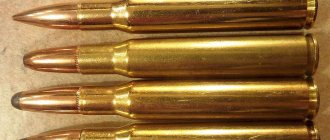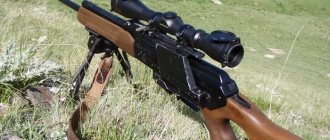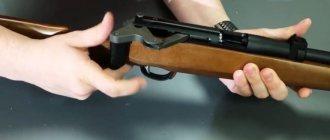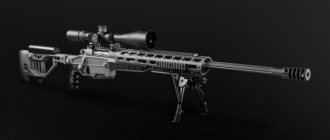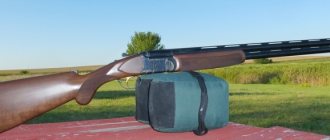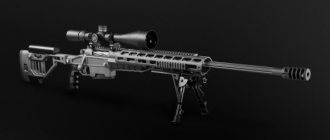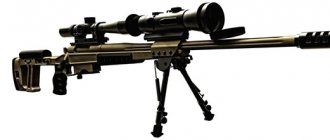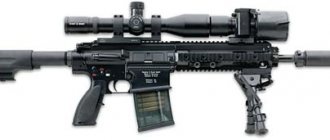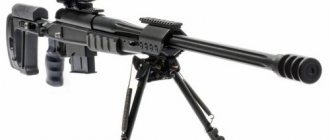The American company Browning needs no introduction in the shooting community - it is one of the most famous and respected brands with more than a century of history. Among the company's products, a special place is occupied by bolt-action and semi-automatic rifles for hunting and target practice.
Browning X-bolt carbines are a relatively new model that replaced the legendary A-Bolt rifles. The X-bolt series was conceived as a simple, reliable and relatively inexpensive weapon for the mass hunter segment. Carbines have been produced since 2008 and in 10 years have managed to win many fans around the world. It must be said that Browning regularly stirs up interest in the line, releasing more and more modifications of the X-bolt.
Two examples of such new products were recently presented in American Las Vegas at the famous SHOT Show and in Nuremberg at the no less prestigious IWA OutdoorClassic exhibition. The weapons community was presented with two versions of the popular model - the X-bolt Target McMillan and the X-bolt SF Chassis. Each of the modifications is interesting in its own way and deserves a detailed story.
X-bolt Target McMillan
This composite model with an adjustable comb is primarily interesting for its stock. The rifle is equipped with the famous tactical polymer stocks A3/A5 manufactured by McMillan. This is another legendary brand that has been producing high-end weapon accessories for over 40 years and works closely with the US military.
Today, polymer stocks McMillan A3 and A5 are in service with the US Marine Corps, and weapons in this design are very popular among ordinary shooters and hunters. Comfortable, durable, reliable, tested in the harshest combat conditions, these stocks are excellent for hunting weapons.
The X-bolt Target McMillan comes in A-TACS LE camouflage. The stock is equipped with an adjustable comb, a soft butt pad and has a textured surface for better grip on the shooter's palms. The receiver is made of high quality steel with a matte black coating. The receiver is threaded for mounting rails for mounting optical sights, but neither the optics nor the rails are included.
The fluted, free-floating barrel is 71 centimeters long, made of stainless steel and equipped with a muzzle brake. The 60-degree lift (right-handed) bolt action features a lock button to protect against unauthorized use. The proprietary Feather Trigger technology provides a smooth, crisp, and easy release.
The total length of the weapon is 116 centimeters, weight is 4.6 kg. The carbine is available in seven different calibers - from the purely American long-range 6MM Creedmoor and 6.5 Creedmoor to the classic caliber 308 Win, which is familiar to many.
Unfortunately, nothing is known yet about the mass production and sale of these rifles. The models were shown at the SHOT Show as a special edition produced for the event. In any case, even when they go on sale, the carbines will cost much more than standard X-bolt modifications - the recommended price indicated on the official Browning website is about $3,000.
Browning A-bolt II rifle
The Browning Company, founded by gunsmith genius John Browning around 1880, is one of the most famous American gun companies, and the A-bolt II is one of the most popular rifles of its type produced today. As I write this, Browning is Belgian-owned but still headquartered in the United States. Modern Browning weapons are produced by the Belgian company FN, the American company ATI and the Japanese company Miroku. A-bolt II rifles are the latest to be produced. Regardless of country of manufacture, Browning firearms are distinguished by their high level of quality, fit and finish.
Brownings have always had a reputation for being premium rifles, yet the A-bolt II is only slightly more expensive than its closest competitors. For example, for the Medallion model in standard calibers in 2005, the manufacturer recommended a retail price of $805. This is comparable to the retail price of the Remington M-700 CDL or the Winchester M-70 Classic Featherweight, which are equivalent in their respective lineups.
There are versions of the A-bolt II rifle with the Brown BOSS system (Ballistic Optimizing Shooting System - a shooting system for optimizing ballistics). This device serves to improve accuracy and reduce recoil; it is a barrel tuner that is also a muzzle brake. There is also a BOSS CR version - just a barrel tuner, without a muzzle brake function. By following simple instructions, the BOSS system can be adjusted so that the vibration of the barrel during firing is optimal for an accurate shot with a specific cartridge. I have tested this system myself and it works. Most A-bolt II rifles with BOSS will produce a sub-minute group at 100 yards (91m). The BOSS system does not allow the installation of open sights on the rifle (except for the rifle in caliber 375H&H).
There are many A-bolt II models available in a variety of calibers and for a variety of applications, from plinking to thick-skinned game hunting. The lineup is quite variable, but as of 2005, as I write this, the following main models are available.
At the top of the range is the White Gold Medallion, featuring a select walnut Monte Carlo stock with a cheekpiece, a rosewood forend and pistol grip rosette, and a rubber buttplate on a brass gasket, cut checkering and a superb high-gloss wood finish. The stainless steel barrel is set in a box of the same material, decorated with gold engraving. The swivels are removable. Available with or without the BOSS system. Rifle weight, depending on barrel length (from 22 to 26 inches (559 to 660 mm)) and caliber, can range from 7 pounds 3 ounces (3.26 kg) to 7 pounds 11 ounces (3.49 kg).
Next up is the Medallion model. Its stock is also made of selected walnut, but the shape of the butt is straight. The tip of the forend and rosette are made of rosewood, but are installed without a gasket; The notch and wood finish are the same as the previous model. The barrel and frame are blued and have a deep shine. The rubber butt pad and swivel mounts are standard. The rifle can be equipped with the BOSS system. The rifle weighs 6 pounds 7 ounces (2.92 kg) in short stroke calibers, 6 pounds 11 ounces (3.03 kg) in long stroke calibers, and 7 pounds 3 ounces (3.26 kg) in magnum calibers. A left-handed version is available.
The Hunter model is the most popular. Its stock is also walnut, but of a more “practical” (Browning’s expression) quality, with a pistol grip and a straight butt, high-quality checkering, and a rubber butt pad. The coating is the same, high gloss. But there is no contrasting end of the fore-end and rosette of the pistol grip. The low-gloss bluing appears durable and comes with standard removable swivels. The Hunter model can be equipped with open sights. Depending on the caliber, the barrel can be 22, 23, 24 or 26 inches (559, 584, 610 or 660 mm) long. This rifle weighs the same as the Medallion model. In the category of not too expensive rifles, the Hunter model is an excellent choice.
The Micro Hunter model is essentially a shortened and lightweight “mountain” version of the regular Hunter model. Depending on the caliber, the barrel can be 20 or 22 inches (508 or 559 mm) long. The stock length is reduced to 13 5/16 inches (338 mm), making the Micro Hunter suitable for smaller people. Weight about 6 ¼ lbs (2.84 kg).
The Hunter FLD model is something between Medallion and Hunter. It has a stock made of selected walnut, and the barrel and frame, like those of the Hunter, are covered with a muted gloss bluing. This model can only be purchased from Browning firearms dealers.
In addition, Browning offers the Eclipse Hunter and Eclipse M-1000 models with laminate stocks. The laminate is gray or black, the stock is Monte Carlo with a cheek piece and a comb hanging over the right hand, with swivels. Metal finish: matte blued. According to the 2002 Shooter's Bible, Eclipse models can have a short- or long-stroke action and a standard barrel; In addition, there is a varmint version with a heavy barrel. All Eclipse models are equipped with the BOSS system. Eclipse M-1000 is a specialized long-range “soybean field rifle.” It has a heavy 26-inch (660 mm) barrel and is only available in 300 Winchester Magnum. Eclipse models weigh from 7 lb 8 oz to 9 lb 1 oz (3.4 to 4.1 kg).
Browning recently offered A-bolt II rifles with synthetic stocks. Of these, the most famous, and deservedly so, is the Stainless Stalker model. It was the world's first production rifle with a composite stock, and is still considered by many to be the best. In any case, it is undeniable that she is one of the most attractive. The Stainless Stalker has a stainless steel box and barrel with a matte silver finish, and a graphite-fiberglass composite stock that is black, well shaped, and has a nicely checkered pistol grip. Black rubber butt pad. This stock has increased durability and temperature stability. The Stainless Stalker weighs from 6 lb 4 oz to 7 lb 3 oz (2.8 to 3.3 kg) depending on caliber and barrel length (22 to 26 inches (559 to 660 mm)).
There is also a Composite Stalker model, similar to the Stainless Stalker, but in blued metal. The BOSS system can be installed on it. This is the simplest of all A-bolt II models.
The Varmint Stalker model has a heavy barrel, a composite stock with a special Dura-Touch coating, and matte blued metal. She weighs 8 to 8 ¼ pounds (3.6 to 3.8 kg). Available in 223 (24 inch (610 mm) barrel) and 22-250 (26 inch (660 mm) barrel).
In 2003, Browning announced the launch of an ultra-short-stroke rifle designed for Winchester Super Short Magnum calibers. Their receivers are approximately half an inch (13 mm) shorter than a conventional short receiver. Rifles with this case are available in Medallion, Hunter, Stainless, Composite and Varmint versions and in calibers 223, 243 and 25 WSSM. They all have a barrel length of 21 inches (533 mm) and weigh 6 pounds 3 ounces (2.8 kg).
All A-bolt II rifle models share common features, the most important of which is an improved trigger with adjustable pull weight. This mechanism is one of two significant modifications compared to A-bolt models, the second modification is a specially designed shutter that prevents jamming. The trigger is wide, grooved, gold plated.
Another important feature is the already mentioned bolt of a special device, placed in a non-rotating tube, with three lugs instead of the usual pair. This reduces the bolt rotation angle to 60 degrees, which in turn speeds up reloading and makes it easier to install an optical sight. The shutter head has a recess and a plunger-type ejector. A small, ingeniously shaped extractor is built into one of the lug lugs. The hole for bleeding powder gases opens into the magazine well. The bolt handle head is one of the highlights of the design. It has the shape of a smooth flat circle inclined at an angle of 30 degrees. Of all the bolt handle heads I've tried, this design is the most comfortable. At the end of the bolt there is a streamlined casing to prevent escaping powder gases from hitting the face and a cocking indicator. The shutter release button is located on the left side of the box at the back. For a very reasonable fee, Browning will engrave the customer's name on the slide.
The magazine is removable, steel, box style, attached to a traditional aluminum hinged cover - a patented Browning design. You can equip the magazine right on the spot, or you can remove it for reloading or replacement. The magazine cover latch is released by a steel button located in front of the aluminum trigger guard.
Another attractive feature is the slide-type rifle safety located on the tang. I consider this fuse to be the most convenient and fastest to use. The safety locks the trigger and blocks the firing pin. In addition, it locks the bolt when closed, preventing unintentional opening if caught on a knot. On all models, the checkering covers ample surface area of the stock, and the checkering style is the traditional Browning diamond point. The rifles are available in all common calibers, from 22 Hornet to 375 H&H Magnum, including all WSM and WSSM calibers, although not every model is available in every caliber.
My experience with Browning rifles has always been positive, including with the A-bolt II Medallion, Hunter, and Stainless Stalker rifles I tested. These are sleek, sophisticated rifles that are a pleasure to own and shoot.
Chuck Hawks
X-bolt SF Chassis
Another modification based on the X-bolt bolt carbine - this time in a tactical version. The rifle stock is a lightweight aluminum frame with polymer inserts; the cheek piece and butt are adjustable in all directions. The design features a stylish Hogue AR15 pistol grip and a 5-round magazine.
The abbreviation SF in the name stands for Super Feather - an improved version of the famous Browning Feather Trigger. It allows you to change the force, increasing the sensitivity of the trigger tenfold and choosing the optimal settings for the most accurate shots.
The carbine is equipped with a rifled, fluted barrel with a muzzle brake and deep grooves. Barrel diameter - 22 mm, length - 61 centimeters, total length of the carbine - 117 centimeters, weight - 5300 grams. The rifle is available in two colors - black and Flat Dark Earth. The weapon is available in .308Win caliber and is equipped with Picatinny or Weaver rails for mounting an optical sight.
Otherwise, the X-bolt SF Chassis model retains the reliable and proven components and technologies of Browning X-bolt. The result is a reliable and incredibly comfortable rifle for precision shooting. It is primarily intended for range practice and shooting competitions, but can also be used for hunting.
Unlike the previous modification, this model, after appearing at exhibitions, was nevertheless put into mass production. In European countries, the cost of X-bolt SF Chassis starts from $2000.
You can choose a rifled hunting carbine for yourself in our catalog of manufacturers and suppliers of hunting goods.
More on the topic:
New hunting rifles SAUER 100
PUMA carabiner - a new concept from Benelli
Specifications
| Characteristic | Meaning |
| Type | Self-loading carbine |
| Caliber | 30-06 SPFLD (cartridge 7.62x63) |
| Barrel length (mm) | 559 |
| Twist pitch (inches) | 10 |
| Magazine capacity | 4 rounds |
| Stock material | Turkish nut |
| Trigger | Unregulated |
| Seats for bars and optics | Eat |
| Overall Length (mm) | 1067 |
| Weight without magazine and optics (kg) | 3,14 |
Design
- A self-loading carbine operating on the principle of a gas piston. The return mechanism is located unusually - under the barrel.
- The bolt has two pairs of lugs; when the barrel is locked, it rotates, providing a seal, like in bolt-action rifles.
- The travel of the USM trigger is not adjustable; the force set by the manufacturer is 1.8 kilograms. The safety box - a button - is located on the rear branch of the trigger guard; to bring the weapon into the firing position, it must be pressed from right to left. The trigger is gold plated.
- There are a couple of external sights. The rear sight is non-adjustable, the front sight is open, with a red fiber-optic thread.
- The receiver is made by milling from a single piece, the outside is plated with nickel and decorated with engraving. The bolt release release lever is located on the right, next to the wooden fore-end.
The magazine's receiving hopper is made of aluminum, and the magazine itself is made of polymer. To access the hopper, you need to open the lid by pressing the lever in front of the trigger guard. The magazine capacity is 4 rounds, the design allows you to fit a fifth round into the chamber.
The stock is semi-pistol, the stock with the handle is removable, the butt plate is rubber, its height can be changed using one of the three included in the delivery set.
Disassembly
The design of the return mechanism consists of many small parts, so self-disassembly of the carbine can be carried out only in cases of extreme necessity.
- Unscrew the screw securing the swivel to the forend and remove it, revealing the gas piston mechanism. To remove the forend, pull the bolt back.
- Remove the butt plate and separate it from the receiver by unscrewing the screw (the groove in its head is very deep).
- Unscrew the plug bolt at the front end of the gas piston chamber.
- Get the split coupling out of the gas chamber by pulling back the weighting block of the return mechanism, and then tap the buttplate of the receiver on the work table, holding the barrel up.
- Remove the gas piston split coupling retaining pin, then push it forward out of the gas piston chamber.
- Press the magazine hopper cover lever and open it.
- Remove the return mechanism guides located on both sides of the hopper.
- Disassemble the return mechanism by removing the weight block, spring and guide.
- Knock out the two mounting pins of the trigger, then pull it towards the buttplate and remove it from the receiver.
- Remove the bolt handle and remove it from the receiver.
Accuracy
The all-new three-lever easy trigger system provides a smooth, dry trigger without pre- or post-fire trigger free play. The factory setting of the trigger force is 1.6 kg and can be adjusted from 1.5 to 2.3 kg. Stability is provided by front and rear dual mounts, which keep the receiver securely in the stock at all times, and which also allows for customization to suit the user. The free-floating, triple-tested Browning barrel delivers even greater accuracy. X-Bolt also offers a more stable optics mounting system with not even two, but four screw holes.
